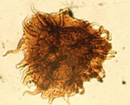Spores by the millions
Plants evolved rapidly during the Devonian Period, but most species were restricted in their distribution in time.
 (52 kb) Plant spores disperse by wind or water and were omnipresent in ancient sediments. Thanks to their resistant walls that facilitate preservation, rocks often contain millions of fossil spores. These tiny grains are indispensable tools for fixing the ages of the subdivisions in the Devonian time scale. At Miguasha, fossil spores helped establish that the Escuminac Formation is the same age as the Upper Devonian reference section in the Frasne region of Belgium, after which the Frasnian Age is named. Fossils that can be used to date rocks are called index fossils.
(52 kb) Plant spores disperse by wind or water and were omnipresent in ancient sediments. Thanks to their resistant walls that facilitate preservation, rocks often contain millions of fossil spores. These tiny grains are indispensable tools for fixing the ages of the subdivisions in the Devonian time scale. At Miguasha, fossil spores helped establish that the Escuminac Formation is the same age as the Upper Devonian reference section in the Frasne region of Belgium, after which the Frasnian Age is named. Fossils that can be used to date rocks are called index fossils.

 (44 kb)More than fifty species of spores have been identified in the Escuminac Formation, demonstrating that plant diversity in the area was much larger than is implied by the limited number of fossilized macro-flora species. There are undoubtedly affinities between the spore assemblages of the Escuminac Formation and those of the “Old Red Sandstone” in Europe because the North American plate (Laurentia) was attached to the European plate (Baltica) in the ancient continent Euramerica during the Upper Devonian. At that time, there was no more than 1,500 kilometres separating the Frasne and Miguasha regions!
(44 kb)More than fifty species of spores have been identified in the Escuminac Formation, demonstrating that plant diversity in the area was much larger than is implied by the limited number of fossilized macro-flora species. There are undoubtedly affinities between the spore assemblages of the Escuminac Formation and those of the “Old Red Sandstone” in Europe because the North American plate (Laurentia) was attached to the European plate (Baltica) in the ancient continent Euramerica during the Upper Devonian. At that time, there was no more than 1,500 kilometres separating the Frasne and Miguasha regions!
Palynology is the study of microfossils with resistant organic walls, such as fossil spores and pollen seeds of continental origin, and acritarchs and chitinozoans of marine origin. The presence of acritarchs in the palynological assemblage at Miguasha indicates that the environment was subjected to both freshwater and marine influences, thus supporting the hypothesis that Miguasha was once the site of an ancient estuary.

 (52 kb) Plant spores disperse by wind or water and were omnipresent in ancient sediments. Thanks to their resistant walls that facilitate preservation, rocks often contain millions of fossil spores. These tiny grains are indispensable tools for fixing the ages of the subdivisions in the Devonian time scale. At Miguasha, fossil spores helped establish that the Escuminac Formation is the same age as the Upper Devonian reference section in the Frasne region of Belgium, after which the Frasnian Age is named. Fossils that can be used to date rocks are called index fossils.
(52 kb) Plant spores disperse by wind or water and were omnipresent in ancient sediments. Thanks to their resistant walls that facilitate preservation, rocks often contain millions of fossil spores. These tiny grains are indispensable tools for fixing the ages of the subdivisions in the Devonian time scale. At Miguasha, fossil spores helped establish that the Escuminac Formation is the same age as the Upper Devonian reference section in the Frasne region of Belgium, after which the Frasnian Age is named. Fossils that can be used to date rocks are called index fossils.
 (44 kb)More than fifty species of spores have been identified in the Escuminac Formation, demonstrating that plant diversity in the area was much larger than is implied by the limited number of fossilized macro-flora species. There are undoubtedly affinities between the spore assemblages of the Escuminac Formation and those of the “Old Red Sandstone” in Europe because the North American plate (Laurentia) was attached to the European plate (Baltica) in the ancient continent Euramerica during the Upper Devonian. At that time, there was no more than 1,500 kilometres separating the Frasne and Miguasha regions!
(44 kb)More than fifty species of spores have been identified in the Escuminac Formation, demonstrating that plant diversity in the area was much larger than is implied by the limited number of fossilized macro-flora species. There are undoubtedly affinities between the spore assemblages of the Escuminac Formation and those of the “Old Red Sandstone” in Europe because the North American plate (Laurentia) was attached to the European plate (Baltica) in the ancient continent Euramerica during the Upper Devonian. At that time, there was no more than 1,500 kilometres separating the Frasne and Miguasha regions!Palynology is the study of microfossils with resistant organic walls, such as fossil spores and pollen seeds of continental origin, and acritarchs and chitinozoans of marine origin. The presence of acritarchs in the palynological assemblage at Miguasha indicates that the environment was subjected to both freshwater and marine influences, thus supporting the hypothesis that Miguasha was once the site of an ancient estuary.
Site map | Feedback | Links | Sources | Credits
Spores by the millions
<< Spermasporites | The animal world >>




